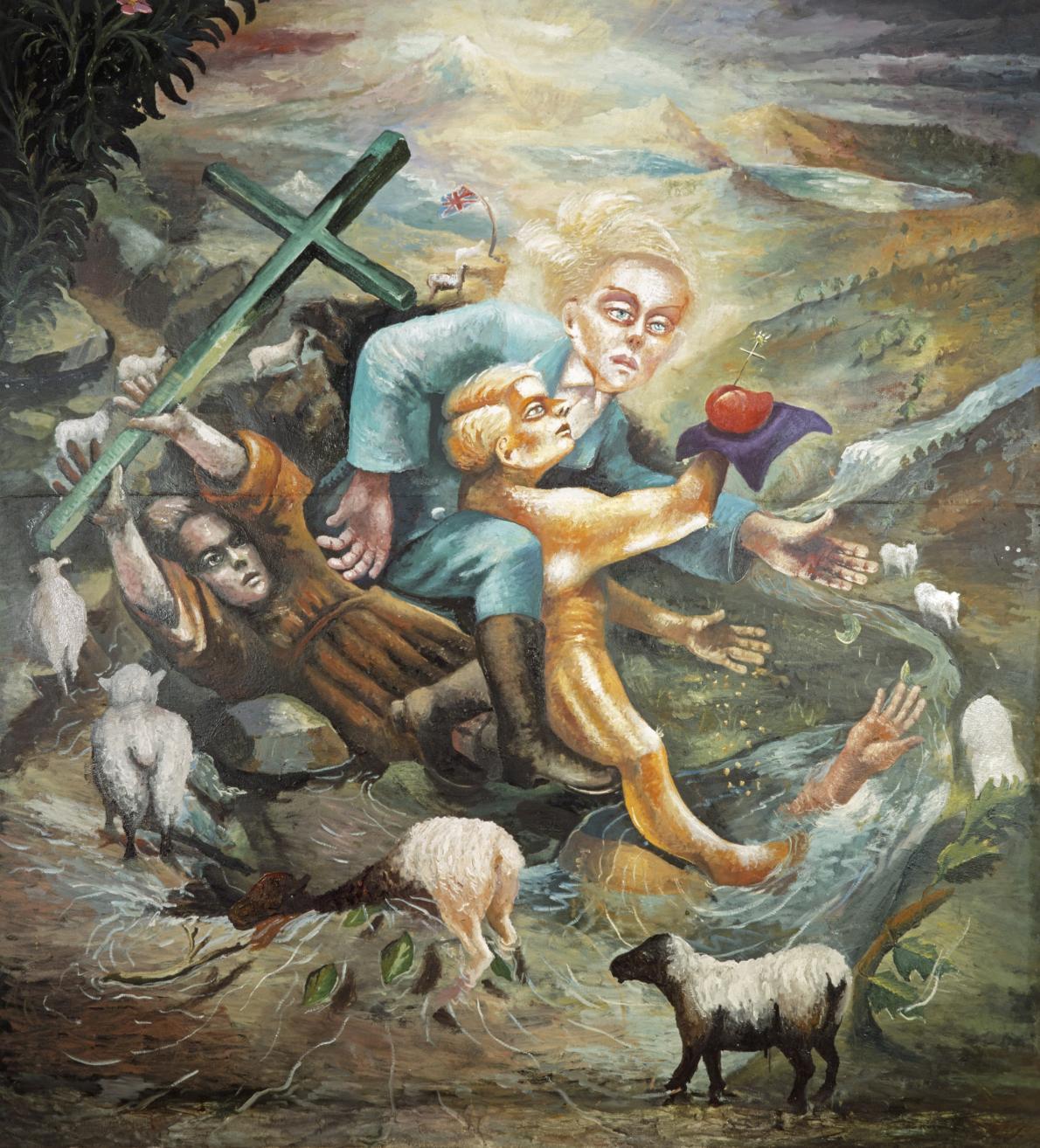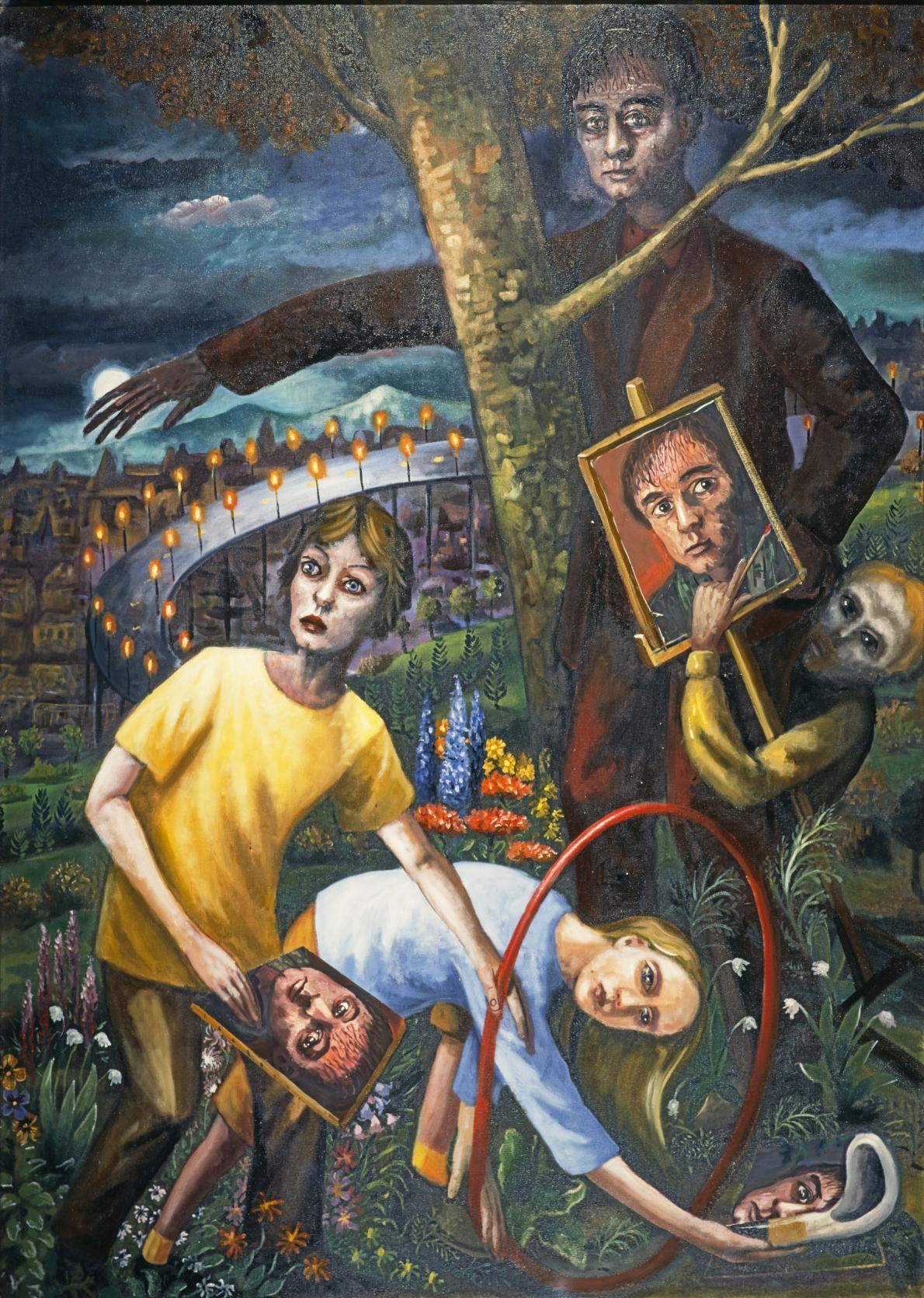Steven Campbell was a Scottish artist who created complex and humorous paintings with roots in performance and installation art. Campbell graduated from the Glasgow School of Art in 1982 and was awarded a Fulbright Scholarship to study at the Pratt Institute in New York the same year. The artist rapidly gained recognition in America, and after a successful period abroad returned to Glasgow in 1987. He remained in Scotland for the rest of his career, developing his position as a link between Scottish artists of the previous generation, and the emerging artists of the 1990s.
Before studying at Glasgow School of Art Campbell was an engineer at the steelworks on the outskirts of Glasgow. After seven years at the steelworks he decided to pursue art. At Glasgow School of Art he was a contemporary of Ken Currie, Peter Howson and Adrian Wiszniewski. Although not a close-knit group, they were dubbed the ‘New Glasgow Boys’, a term Campbell disliked. They each became well known and contributed significantly to Scottish contemporary art, with a shared commitment to figurative painting.
During the 1980s Campbell’s work weaved a narrative of recurring figures in a somewhat surreal and disordered world. The stocky, tweed-clad male characters are philosophers, artists, and architects who navigate this puzzling, paradoxical world in search of meaning. These paintings do not offer any fixed interpretation, instead there are suggestions of historical and contemporary references and connections.
Throughout his studies Campbell was particularly interested in performance and installation art. He found that these mediums provided him with a fresh perspective on painting, and in his final years at art school he created performance works. Extending this influence further, one of his most significant works On Form and Fiction 1989-90 brings together painting, drawing, and music to create an immersive experience along the lines of an installation.
Performance
During his first three years at Glasgow School of Art Campbell explored installation and performance art. He was influenced by conceptual artists Gilbert & George, Bruce McLean and Robert Wilson, all of whom took an ironic and satirical approach to performance. Poised Murder 1981 is one of Campbell’s most significant fully-realised performance works; presenting a stylised world of a fictional detective with echoes of film noir. Lasting 15 minutes, the music stopped four times during the performance at which point a different murder was performed with real razors and knives. As a visual homage to real-life murders, this work highlights the enduring themes and subjects in Campbell’s work of mystery, murder, and a sense of danger.
Although the artist pursued painting as his preferred medium, performance always remained an influence on his work. Speaking of how he works the artist said ‘When you’re in your own world of your own making, and you’re your own director, writer, producer, and actor inside a drama that might change by ten brushstrokes, it can be wonderful’ (Campbell quoted in ‘Steven Campbell Unfinished’ 2010). Campbell created dense painted worlds which figures, or characters, occupied and tried to navigate. In Elegant Gestures of the Drowned after Max Ernst 1986 Campbell presents a performance suspended in time. St Christopher and the infant Christ are separated by a man in a suit, who could be the artist himself. The painting is chaotic and full of movement as sheep flee the scene in a winding line, and a hand pushes up from the river below. The painting potentially alludes to the Falklands War of 1982 as the Union Jack bends and wavers in the background. This bustling composition is typical of Campbell’s painting; in one canvas we see religious and political themes underpinned by an art historical reference in the title. In this case he refers to the German Dada and Surrealist artist Max Ernst.
A turning point in Campbell’s work came in 1990 at his solo exhibition at the Third Eye Centre in Glasgow (now the Centre for Contemporary Art). The centrepiece of the show, On Form and Fiction 1990, combined painting with elements of installation art. On Form and Fiction consisted of 150 monochrome ink drawings on paper and 12 larger acrylic paintings on paper. The works in ink covered the walls like wallpaper and were punctuated by the 12 larger framed acrylic paintings. The artist created an immersive experience with low lighting, benches from Kelvingrove Gallery Glasgow and a record player looping ‘Je t'aime…moi non plus’ by Jane Birkin and Serge Gainsbourg. Campbell worked furiously to create two drawings a day for this work, resulting in an all-encompassing display which allowed visitors to enter a world of his creation. Typical of Campbell’s work, there are various knowing and ironic references to art history, and while humorous, there is a serious undertone. On Form and Fiction blurred the lines between painting, installation and performance, making it a catalyst for the following generation of Scottish artists. In 2014 this work was restaged for the first time at the National Galleries of Scotland as part of the national exhibition, ‘GENERATION: 25 Years of Contemporary Art in Scotland’. In 2016 the National Galleries of Scotland and Glasgow Life jointly acquired this work which now consists of 105 drawings and nine paintings.
Figurative Painting
Throughout his career Campbell looked to the long tradition of figurative painting and delved into art history and theory to inform his work. By focusing on the figure and taking a narrative approach (themes which were challenged and rebuked in Modern Art of the early twentieth-century), Campbell asserted his position in the Postmodern style. Across Europe in the 1980s, figurative art was a common theme. However, during the 1960s and 1970s artists Sandy Moffat (who also taught Campbell at art school) and John Bellany had led a return of monumental figurative painting in Scotland. During the same period conceptual and minimal art were popular, and while in stark opposition to Campbell’s work, these movements provided him with a new approach and a fresh perspective on painting. Conceptual and minimal art reopened the possibilities of painted subject matter, and the revival of figurative art in painting is also connected to performance which was a ‘kind of deconstruction of figurative art’ (Macmillan 1993, p.17).
Figures in Campbell’s early paintings are hefty and bulky. In Ding Dong 1982 the canvas is dominated by a stocky woman who stands stiffly with one arm outstretched, and chains dangling from both arms. Her body is composed of blunt, cylindrical shapes and is reminiscent of French artist Fernand Léger’s rounded cubist figures, and Pablo Picasso’s defiant female figures which he painted around 1920. Campbell was influenced by early twentieth-century modern painters including Picasso, the subject of Campbell’s final year dissertation, and Paul Cézanne who was one of his favourite artists.
Campbell’s commitment to figurative painting led to the creation of a cast of characters who occupy the paradoxical worlds of the canvas. Characters were developed as early as art school and recur in Campbell’s work throughout his career. Large men influenced by both historical and fictional figures of the 1920s to 1940s traverse the landscapes Campbell creates. A prominent character referred to as Hunt was created in the artist’s final year at Glasgow School of Art and was inspired by 1940s murder magazines. Representing the dark side of morality and evil temptations, Hunt appears in various guises and develops into other characters including the Lost Hiker. Van Helsing, the fabled vampire hunter of Bram Stoker’s Dracula, is also a recurring character. Coincidentally, Campbell won the Bram Stoker Prize in his third year at Glasgow School of Art in 1982 for the ‘Best Imaginative Work of the Year’. Campbell would speak of characters with a familiarity as if they were more than a fictional cast, and while not self-portraits it is thought that the characters represent elements of himself and the darker side of human behaviour and experience.
Surrealism
Returning to Scotland in 1987 after five years in New York, Campbell’s work was more expressive, surreal in content and mood, and his treatment of the paint was richer. Working with fierce conviction and energy, he created dense, complicated scenes which aligned him with the surrealist artists of the early twentieth-century. Surrealism promoted the idea that a two-dimensional picture is the equivalent, not to real space, but to mental space which holds memories, dreams and perceptions. Campbell’s approach to his work was instinctive and he did not create preparatory drawings or sketches for his paintings. This allowed a personal and internal exploration, outside of coherent narrative, to come together on the canvas.
During the 1990s figurative painting fell out of vogue with a new generation of artists acting against the painterly tradition which preceded them. This was a difficult period for Campbell, and his work of this time reflects both his personal struggles and a reaction to societal difficulties. The clown-like humour and wit is replaced with a dark irony and more explicit distress. Experimenting with materials, he began incorporating collaged elements into his paintings. He was particularly intrigued by textiles and painstakingly worked with string which he applied to canvas to mimic tapestry. ‘I thought people would be attracted by the sheer craziness of building a work up starting with a piece of string. It was only the madness I was interested in. To do the task was all I believed in’ (Steven Campbell quoted in Macmillan 1993, p.71). A Small Death in the Family 1991 depicts a mother and child with another small child lying at their feet. Beatrix Potter’s character Peter Rabbit crosses the foreground and a bullfight scene dominates the background. In this work the artist refers to Surrealist artist René Magritte’s painting Discovery 1927, in which a female figure undergoes a metamorphosis, her skin turning to wood. The artist said that he wanted to take Magritte’s absurdity even further by creating the female figure in string. The dark subject that is further clarified by the title of Campbell’s work, is led by a surreal sensibility allowing the artist to express irony in a different way.
The surreal quality of Campbell’s work is not solely connected to the surrealist artists of the twentieth-century. Rather it is also closely linked to the work of film directors influenced by surrealism, particularly Alfred Hitchcock and David Lynch. This cinematic influence can be traced from Campbell’s early performance work while he was studying at Glasgow School of Art, right up to his final paintings. Alfred Hitchcock, a pioneer of suspense and psychological thrillers, was a starting point for several of Campbell’s paintings in the early 2000s. In the diptych painting No bathroom evidence painting can explain the fact that there is no rug in Psycho 2001 Campbell reimagines the murder scene in Hitchcock’s ‘Psycho’ which takes place in a bathroom. The title is true in that there is no rug in the film’s murder scene, which Campbell imagines would hold some residue or evidence of the murder. He adds this suggested rug to the painting, and in the second part of the diptych we see that the rug is composed of naked bodies merging with foliage and flowers. The work directly references ‘Psycho’ but occupies imagined realities through details and a collaged approach to the composition. As is typical of his work, Campbell creates an immersive painting which draws us into a complex surreal narrative with figures suspended in a performance.
References
Andrew Nairne (ed), Steven Campbell: on form and fiction, exhibition catalogue, Third Eye Centre, Glasgow 1990.
Duncan Macmillan, The Paintings of Steven Campbell: The Story so Far, Edinburgh and London 1993.
Kathy Chambers and Neil Mulholland, Steven Campbell (1953-2007) “... Wretched stars, insatiable heaven …” Paintings 2006-2007, exhibition catalogue, Marlborough Fine Art, London 2009.
Stephen J. Sinclair, Steven Campbell: Unfinished, documentary commissioned through the Steven Campbell Trust and Cardonald College in 2010, https://vimeo.com/20857242




